Gain insight into the biblical span, an ancient measure of length, and discover its historical significance in scripture.

How Long Is a Span in the Bible
Just as a tapestry weaves threads to create a larger picture, the Bible interlaces measurements like the span to construct a broader understanding of its world.
You're likely familiar with modern metrics, but have you considered how a span, an ancient unit of length based on the human hand, connects us to the past?
This exploration into the biblical span not only uncovers its historical significance but also invites you to bridge the gap between ancient and contemporary units of measure.
Let's embark on this journey to unravel the mysteries of the span and its enduring relevance in sacred texts.
Key Takeaways
- A span in the Bible is a unit of measurement based on the human hand's breadth.
- Biblical spans were used for quantifying objects, distances, and in construction.
- The length of a span can vary, reflecting historical and cultural measurement practices.
- Understanding biblical spans provides insights into ancient cultures and their connection to the divine.
Understanding Biblical Measurements
To accurately interpret the biblical text, you must first grasp the significance and specifics of its varied measurements, such as a span. Understanding these units is crucial because they provide context to the descriptions and instructions found within the scriptures. The metric influence on modern interpretations of these measurements can't be overstated. It serves as a bridge, allowing you to translate ancient units into more familiar and universally understood terms.
A span, traditionally considered the distance from the tip of the thumb to the tip of the little finger when the hand is fully extended, roughly translates to about half a cubit or approximately 9 inches (22.9 cm) in today's measurements. However, measurement accuracy in the biblical context goes beyond simply converting ancient units to their modern equivalents. It involves understanding the cultural, historical, and practical reasons behind the use of these measurements.
For instance, the use of body parts like the span as units of measurement reflects the practical and accessible nature of ancient measuring systems. People relied on what was readily available to them— their own bodies—to measure lengths, widths, and distances. This method, while seemingly imprecise by today's standards, provided a sufficient degree of accuracy for the needs of the time.
The Historical Significance of a Span

You'll find that a span's role in ancient measurement standards isn't just a relic of the past but a foundation for understanding biblical narratives.
Its use throughout biblical texts offers insights into the everyday lives and spiritual practices of ancient cultures.
Moreover, the span's influence extends into modern times, shaping cultural perceptions and interpretations of biblical history.
Ancient Measurement Standards
In the context of ancient measurement standards, a span holds significant historical importance as a unit of length based on the human hand's breadth, from the tip of the thumb to the tip of the little finger when extended. This unit reflects the practical and tangible aspect of measurement before the advent of the Metric system and digital evolution.
Ancient civilizations relied on human body parts for measurement, ensuring universality and accessibility across cultures. The span, as an anthropometric unit, underscores a direct connection between human proportions and the way spaces and objects were historically quantified. This method offered a personalized dimension to measurement, contrasting sharply with today's abstract and standardized systems.
Understanding this transition highlights how deeply measurement practices are embedded in the fabric of cultural and technological evolution.
Biblical Span Uses
Understanding the role of a span in ancient measurement illuminates its biblical significance, where it served as a fundamental unit in quantifying objects and distances in sacred texts. The span's significance extends beyond a mere measure; it symbolizes the human connection to the divine, bridging the gap between earthly and heavenly realms.
However, this reliance on a bodily measure also introduced measurement inaccuracies, as spans could vary slightly from person to person. Despite these inconsistencies, spans were pivotal in constructing, trading, and daily life, underscoring the adaptability and resourcefulness of ancient peoples.
This balance between practicality and imprecision highlights the span's complex role in biblical narratives, where it anchored the spiritual to the tangible.
Cultural Impact Today
Despite its ancient origins, the span's historical significance continues to resonate in modern culture, shaping our understanding of measurement and cultural identity. This unit of length, once crucial for daily activities, now influences modern fashion and architectural design, highlighting its enduring relevance.
Field |
Impact of Span |
|---|---|
Modern Fashion |
Inspires patterns and garment sizing |
Architectural Design |
Influences proportions and spatial planning |
Cultural Identity |
Encourages appreciation of historical measurement systems |
Measurement Understanding |
Enhances awareness of non-standard units |
The span's legacy is evident in the meticulous designs of contemporary buildings and the precision of clothing patterns. Its role in developing a deeper appreciation for cultural identity and measurement diversity showcases its timeless relevance, proving that ancient measures still shape our modern world.
Biblical References to the Span

You'll find that the span, an ancient unit of measurement from fingertip to thumb, is deeply rooted in Biblical texts. Its usage in scripture provides not only practical examples of distances and dimensions but also possesses a rich symbolic meaning that underscores various theological themes.
Span Measurement Origins
The span, an ancient unit of length mentioned in the Bible, originates from the distance between the tip of the thumb and the tip of the little finger when the hand is fully extended. This measurement technique, while not uniform across all individuals, provided a basis for span accuracy in ancient times.
- Personal Variation: The span varied from person to person, affecting measurement standardization.
- Cultural Adoption: Different cultures adopted the span, leading to variations in actual length.
- Measurement Techniques: Ancients developed methods to increase uniformity.
- Historical Context: The span's use reflects the practicality of using the human body as a measurement tool.
- Precision and Utility: Despite its variability, the span served as an effective measure for everyday tasks, illustrating the balance between precision and utility in ancient measurements.
Examples in Scripture
Building on the understanding of the span as a fundamental measure rooted in human anatomy, let's examine its application and significance within biblical narratives. The Bible often uses spans as part of its architectural and object measurement descriptions. However, due to the personalized nature of a span, rooted in an individual's hand size, span calculations can vary, leading to measurement inaccuracies.
Reference |
Context |
Importance |
|---|---|---|
Exodus 28:16 |
Dimensions of the breastplate |
Showcases precise craftsmanship requirements |
1 Samuel 17:4 |
Height of Goliath |
Highlights extraordinary physical stature |
Ezekiel 43:13 |
Altar measurements |
Emphasizes sacred precision |
These examples reflect the span's practicality and the challenges in ensuring uniformity in measurements across different contexts and individuals.
Span's Symbolic Meaning
In exploring the Bible, it becomes clear that the span isn't only a unit of measurement but also carries significant symbolic weight, representing human limitations in the context of divine infinity. The use of span allegories and measurement metaphors enriches scriptural narratives, pointing to deeper truths about humanity's place in the universe.
- Span symbolizes the finite nature of human life and understanding.
- It contrasts with God's eternal and infinite nature.
- Serves as a reminder of humility before the divine.
- Highlights the gap between human capability and God's omnipotence.
- Encourages reflection on the transient nature of earthly concerns.
Comparing Ancient and Modern Measurements
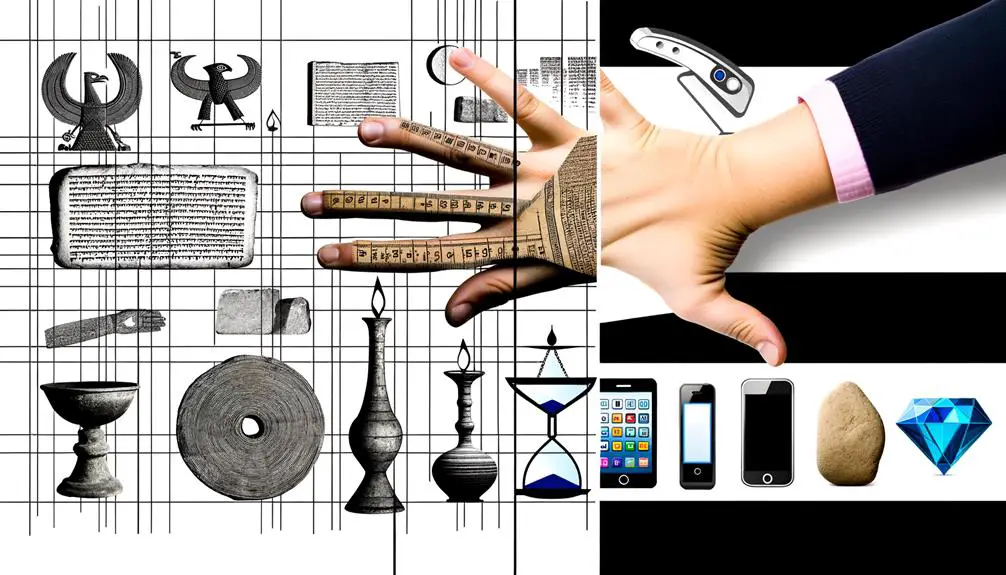
Understanding the Bible's measurement of a span requires comparing it to modern equivalents, revealing the evolution of measurement systems over millennia. Historically, a span is considered the distance from the tip of the thumb to the tip of the little finger when the hand is fully extended, approximately half a cubit or 9 inches (about 22.9 cm). This measurement, while seemingly straightforward, diverges significantly when placed against the backdrop of today's metric comparison.
The modern relevance of understanding the biblical span lies not just in historical curiosity but in grasping the tangible realities of ancient life and narrative context. In today's terms, using the metric system, a span translates roughly to 22.86 centimeters. This metric comparison bridges the gap between ancient and contemporary measurement systems, offering a concrete sense of scale and distance that can be elusive when reading historical texts.
Analyzing the span within this framework highlights a critical aspect of human history: the standardization of measurements. While ancient peoples relied on body-based units like the span, modern society has shifted towards a universal metric system, aiming for precision and universality. This transition underscores the evolution from a tactile, personal system of measurement to a standardized, impersonal one. It's a testament to humanity's relentless pursuit of accuracy, efficiency, and shared understanding across cultures and time periods.
Therefore, when you delve into biblical measurements such as the span, you're not just uncovering a unit of length. You're navigating the rich tapestry of human progress in understanding, dividing, and conquering the physical world. This journey from the span to the centimeter embodies our collective march towards a more connected and comprehensible global village.
The Span in Daily Life
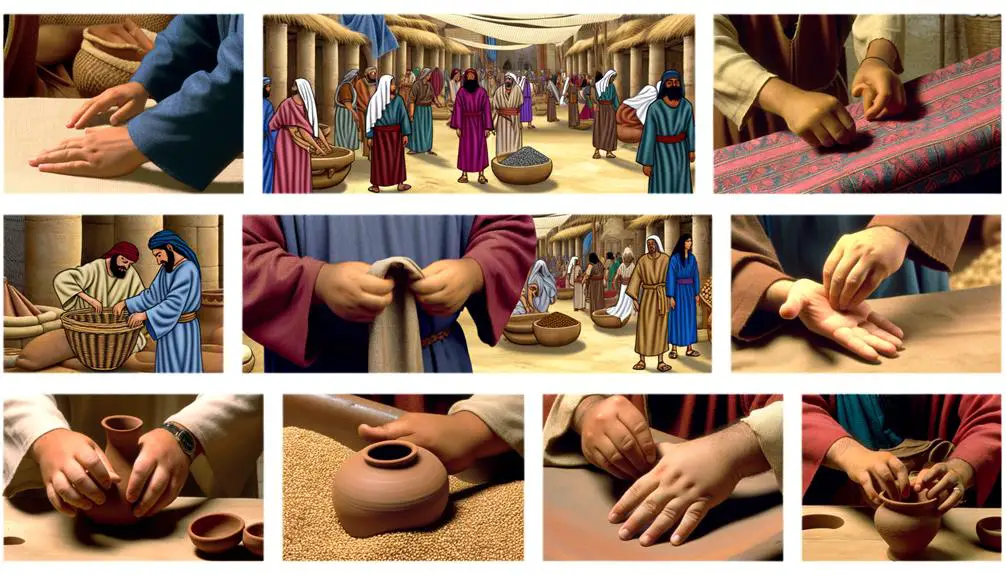
How did the measurement of a span integrate into the daily lives of ancient people, shaping their routines and interactions? The span, a unit of measurement from the tip of the thumb to the tip of the little finger when the hand is fully extended, wasn't just a measure but a tool that influenced various aspects of daily life. It's fascinating to see how this ancient measure finds echoes in modern ergonomics and fabric measurement, underscoring its relevance across time.
- Trade and Commerce: In markets, a span was a quick and handy way for vendors and buyers to agree on sizes and quantities of goods, from fabrics to agricultural products. This practice ensured fairness and efficiency in transactions.
- Construction and Craftsmanship: Builders and craftsmen used the span for measuring dimensions on-site without the need for cumbersome tools. This facilitated the construction of homes and the creation of household items, making the span integral to community development.
- Clothing Production: When measuring fabric, the span provided a personal touch, allowing tailors to create garments that fit perfectly. This bespoke approach to clothing production highlights the personalization that was possible even in ancient times.
- Agriculture: Farmers used the span to space out seeds and plants, optimizing growth and yield. This method demonstrates an early form of precision agriculture.
- Education and Learning: The span served as a practical teaching tool for basic arithmetic and geometry, showing children how to measure and calculate using their own bodies.
In every facet of ancient life, the span bridged the gap between the physical and the conceptual, embedding itself deeply into the fabric of society. Its legacy persists, subtly influencing practices in modern ergonomics and fabric measurement, underscoring the timeless nature of human ingenuity.
Variations Across Cultures and Periods
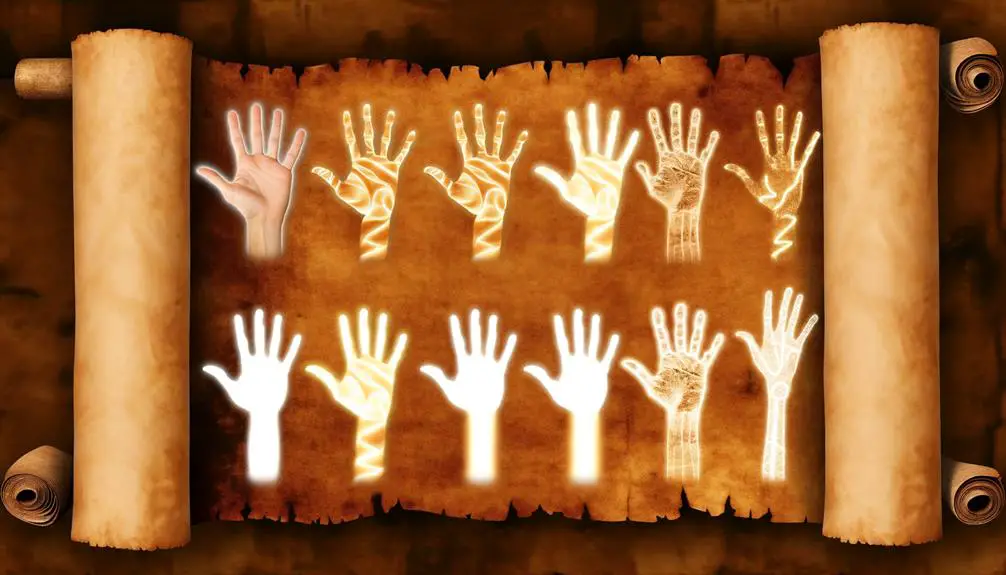
Exploring the span's role across different cultures and periods reveals a fascinating tapestry of measurement practices that were uniquely adapted to local needs and environments. You'll find that, throughout history, the concept of a span as a distance from the tip of the thumb to the tip of the little finger when spread, has been remarkably consistent, yet its actual length can vary significantly. This variation isn't merely a historical curiosity; it's a window into how societies have interacted with their physical and social worlds.
In ancient times, the absence of standard measurement units meant that the span, alongside other body-based measures like the foot and the cubit, was crucial for constructing buildings, creating clothing, and trading goods. These measures were inherently local, reflecting the average dimensions of the population. As societies interacted through trade and conquest, these measurement systems came into contact, sometimes merging, sometimes competing.
Modern interpretations of the span, however, are informed by advances in measurement technology. Precision tools and the establishment of international standards have relegated the span to a historical footnote in many parts of the world. Yet, it remains a key unit in various traditional practices and in cultures where modern measurement technology isn't pervasive or is deliberately eschewed for traditional reasons.
This journey from a universally understood but variably defined measure to a more standardized yet culturally specific unit illustrates the dynamic interplay between technology, culture, and measurement. The span's story is a microcosm of human adaptation and innovation, reflecting our ongoing quest to make sense of the world around us and to communicate that understanding across cultures and through time.
Mathematical Conversions Explained
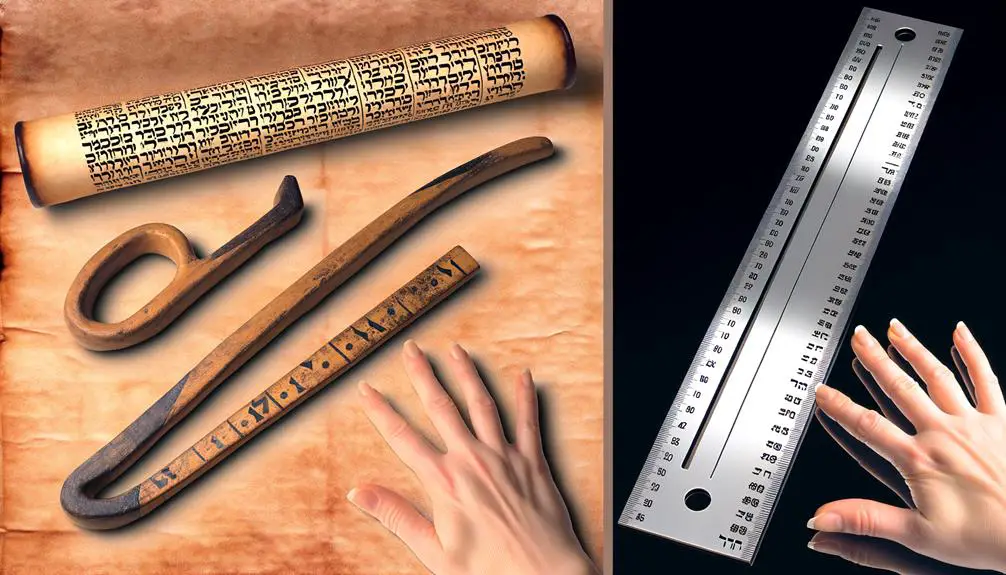
To accurately convert biblical spans into modern units, you'll need to grasp the underlying principles and specific measurements that scholars have identified through historical texts and archaeological evidence. This process involves understanding both the ancient unit of measurement and its relationship with contemporary systems like the metric system. Digital conversion tools have simplified this task, yet it's vital to comprehend the basics to ensure accuracy.
Here are key aspects to consider:
- Historical Context: The span in biblical times varied slightly depending on the region and period. It's essential to identify the specific context of the text you're working with.
- Standard Measurement Equivalents: Scholars generally agree that a biblical span is roughly half a cubit, translating to about 9 inches or 22.86 centimeters in today's measurements.
- Metric System Integration: For those using the metric system, understanding how to convert inches to centimeters is crucial. Remember, 1 inch equals approximately 2.54 centimeters.
- Digital Conversion Tools: Utilize digital tools and calculators for quick conversion. These platforms often update their databases with the latest scholarly research to provide accurate conversions.
- Cross-Verification: Always cross-verify your conversions with multiple sources or digital tools to ensure accuracy, given the slight variations in measurement interpretation.
The Role of the Span in Sacred Texts

In sacred texts, the span serves as a fundamental unit of measurement, illuminating various aspects of ancient rituals, construction, and symbolism. You'll find that the span isn't just a rudimentary length marker; it's imbued with layers of meaning that have evolved over time. This evolution reflects a deepening understanding of the universe and the divine, showcasing how people have sought to quantify and make sense of the world around them.
Span symbolism, in particular, highlights the intersection between the tangible and intangible. For instance, spans were often used to describe the dimensions of sacred objects or spaces, suggesting a bridge between the human and the divine. This symbolic use underscores a belief in the sanctity and order of the universe, with measurements acting as a means to comprehend and participate in its divine structure.
The table below outlines key aspects of the span's role in sacred texts, from its practical applications to its symbolic significance:
Aspect |
Description |
Significance |
|---|---|---|
Construction |
Used in detailing dimensions of sacred structures |
Reflects precision and sanctity |
Rituals |
Measurements for offerings and altars |
Symbolizes devotion and understanding |
Symbolism |
Represents divine-human connection |
Enhances spiritual comprehension |
Measurement Evolution |
Shows progression from simple to complex systems |
Indicates growth in knowledge and spirituality |
Cultural Impact |
Influences on art, literature, and architecture |
Demonstrates enduring relevance |
As you delve deeper into the role of the span in sacred texts, you'll appreciate its significance not just as a unit of measurement but as a symbol of humanity's quest to understand and connect with the divine.
Frequently Asked Questions
How Did the Concept of a Span Influence Trade and Commerce in Biblical Times?
In biblical times, the span played a crucial role in shaping trade dynamics. By providing a common unit of measure, it ensured measurement consistency across various regions.
This uniformity facilitated smoother transactions, as traders didn't have to haggle over differing local standards. Consequently, the span's adoption boosted commerce efficiency, allowing markets to expand and economies to grow.
It was more than a measurement; it was a foundation for economic interaction.
Are There Any Specific Rituals or Religious Ceremonies in the Bible Where the Measurement of a Span Plays a Critical Role?
You might wonder if any religious ceremonies in the Bible emphasize the importance of a span's measurement.
While specific rituals don't highlight a span's length directly, the concept of a span carries significant symbolism in biblical narratives.
Measurement traditions in these texts often reflect themes of divine order and human limitation.
The span, as a unit, subtly underscores these themes, weaving into the fabric of biblical symbolism without centering on precise ritualistic uses.
Can the Length of a Span Be Linked to Any Specific Biblical Characters or Figures, Suggesting Their Physical Attributes?
You're diving into a world of giant speculation when pondering if a span's length can hint at biblical characters' heights.
Surprisingly, no direct link ties this measurement to specific figures, despite the allure of imagining towering giants or diminutive heroes.
This absence isn't an oversight but a testament to the Bible's focus on spiritual, not physical, dimensions. Measurement symbolism in the text emphasizes moral and prophetic messages over literal physical attributes.
How Has the Interpretation of a Span's Length Evolved in Various Modern Christian Denominations?
In modern Christian denominations, you'll find that the interpretation of a span's length isn't uniform. Denominational debates and modern translations play crucial roles in these variances. Scholars and theologians delve into ancient texts and contexts to argue their stances, making the span's length a topic of intricate analysis.
This evolution reflects broader discussions on biblical accuracy and the quest for authenticity in scriptural understanding. You're witnessing a dynamic, ongoing exploration of biblical measures.
Is There Any Evidence of the Span Being Used Metaphorically in the Bible to Convey Deeper Spiritual or Moral Lessons?
You're exploring whether the Bible uses the span metaphorically to impart deeper spiritual or moral lessons. Indeed, it does.
The span's metaphorical significance isn't just about physical measurement; it's rich in spiritual symbolism. Through its use, scriptures convey themes of God's intimate involvement in creation and human life.
This approach underscores the closeness of the divine-human relationship, emphasizing God's personal care and the precision of His work in the world.
Conclusion
So, after delving deep into the ancient and somewhat mystical world of biblical measurements, you've uncovered the elusive span.
It turns out, this archaic unit of length, so casually tossed around in sacred texts, is about as straightforward as a camel passing through the eye of a needle.
Who'd have thought that something as simple as the distance from a thumb to a little finger could lead us on such a scholarly quest?
Yet, here we are, measuring divinity with the palm of our hands.

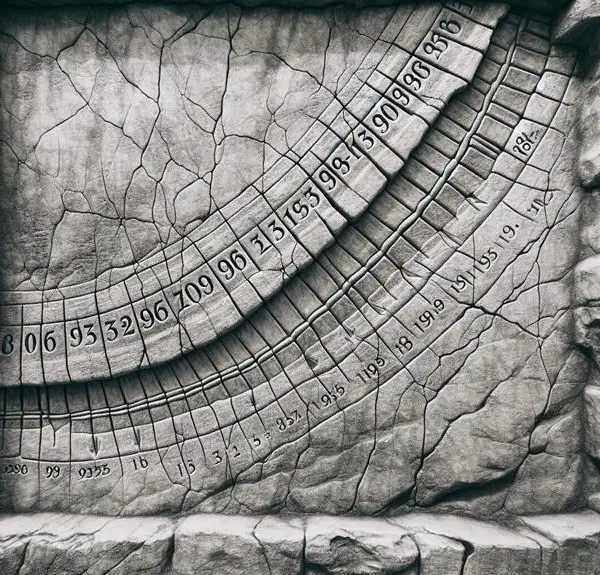

Sign up